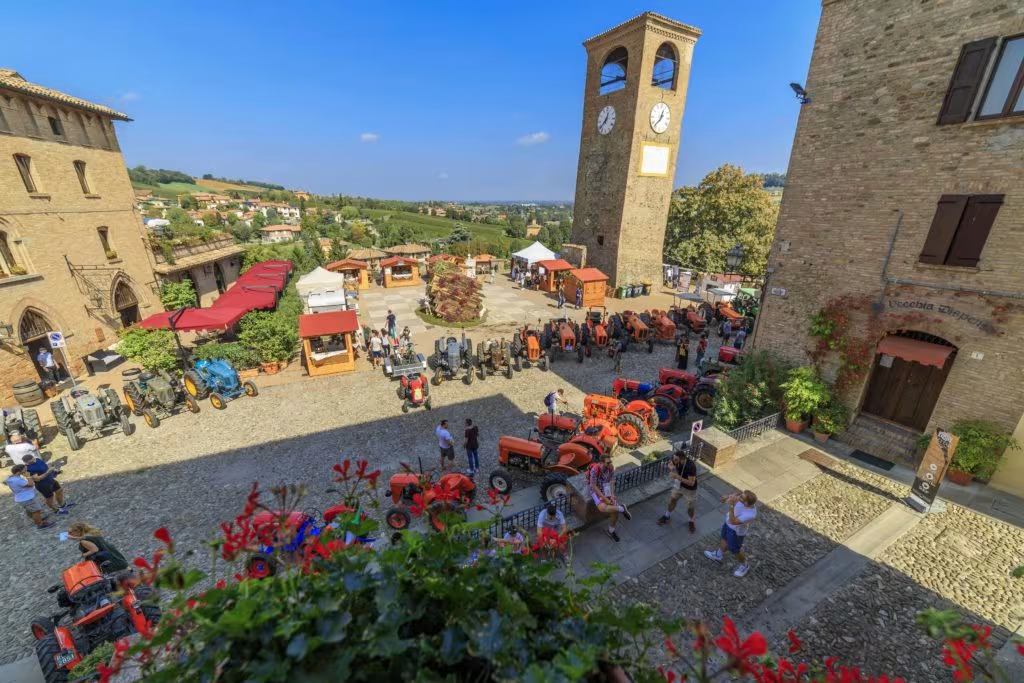Castelvetro's Timeless September Celebration of Harvest and Heritage
- Alessandro Loja
- Aug 9
- 3 min read
Updated: Aug 16

Castelvetro di Modena sparkles in its most festive garb as the Emilia-Romagna hills change amber and gold in the first blush of fall. This mediaeval settlement, which sits like a crown above the vineyards, is the focal point of the centuries-old Sagra dell’Uva e del Lambrusco Grasparossa, which will be held in 2025 on September 20–21 and 26–27–28. What started off as a get-together of nearby farmers to celebrate the end of the grape harvest has developed into a charming yet simple occasion that combines the joy of social celebration with agricultural heritage.
The piazzas are lined with stalls full of large clusters of Grasparossa grapes, their skins shining in the September sunshine. Winemakers serve sparkling glasses of Lambrusco Grasparossa, the product of their labours, which is rich in character and deep in colour. Before allowing the tannic embrace to linger on the palate, guests swirl the wine, taking in its violet and wild berry flavours. With the help of dancers, musicians, and the soft, sweet laughter of those who understand that the harvest is more than simply an agricultural event but also a cultural one, the Carri di Bacco, parade floats covered in vines, roll slowly over the cobblestones in the streets.
Beyond Grapes, The Living Terroir

Nearly all of the red grape varietal Lambrusco Grasparossa is grown in the hills surrounding Castelvetro di Modena. The grapes ripen later than many other types because it grows well in clay-rich soils that hold onto heat. Compared to other Lambrusco varieties cultivated in the plains, this produces wines with a deeper ruby colour, stronger tannin content, and a more robust structure. Although Lambrusco Grasparossa is frequently made in a softly sparkling (frizzante) style, it can also be dry (secco) or slightly off-dry (amabile). It has strong notes of violets and dark cherries, as well as a well-balanced acidity that makes it a versatile wine to serve at the table.

In its homeland, it naturally pairs well with the rich flavours of Emilia, such as robust lasagne, tortellini in brodo, or gnocco fritto with cured meats. Its fruity overtones reverberate the sweetness of balsamic glazes and roasted pumpkin dishes, while its fizz clears the palate of the fattiness of salumi. Beyond custom, Grasparossa goes well with aged cheeses, barbecue, and spicy charcuterie, demonstrating that this wine's adaptability is as abundant as its character.
Village in Festa: When Culture Comes to Life
The old centre of Castelvetro is transformed into a stage without walls during the event. Folk tunes are played by musicians beneath the ochre facades and timbered balconies, and they permeate the alleys like the aroma of fermenting must. Visitors are reminded that culture here is not preserved in glass cases but rather experienced outdoors by actors dressed in historical costumes performing scenes from another era's rural life, such as grape pressing, market banter and traditional dances.
Via Sinistra Guerro becomes a passageway for artisans. A tactile map of the area is provided by stall after stand: freshly baked crescentine that go almost as soon as they appear, cured meats with the bloom of meticulous ageing, hand-thrown ceramics still warm from the kiln, and jars of honey from hillside hives. Locals are happy to share a dish, a tale, or the location of a vineyard walk that overlooks the Apennine foothills for those seeking a more personal experience.
Travel here is best approached slowly. This location is ideal for taking winding detours, such as following the curvature of a road that runs along a hill, stopping at a winery along the way, or taking a moment to observe the light filtering through the vineyards. According to Castelvetro, beauty is in letting experiences develop, like wine in a glass, layer after layer, note after note, rather than hurrying to gather them all.
.png)





